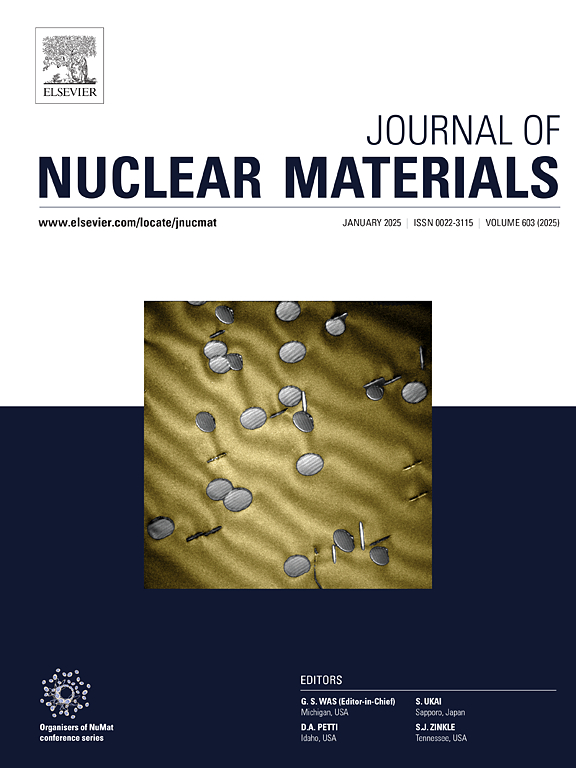Impact of anisotropic grain microstructure on the fracture-mechanical properties of ITER grade tungsten plate
IF 3.2
2区 工程技术
Q3 MATERIALS SCIENCE, MULTIDISCIPLINARY
引用次数: 0
Abstract
The fracture-mechanical behavior of a uniaxially rolled ITER grade tungsten plate has been investigated up to test temperatures of 700°C. To study the influence of the anisotropic grain microstructure on the Ductile-to-Brittle Transition Temperature (DBTT) and failure mechanism, fracture toughness testing has been performed for four specimen extraction orientations: longitudinal - long transverse (L-T), long transverse - longitudinal (T-L), longitudinal - short transverse (L-S) and long transverse - short transverse (T-S). The DBTTs were at around 250°C and 300°C in L-T and T-L orientations, respectively. In the case of L-S and T-S orientations, the crack deflection prevented unambiguous identification of the DBTT. An upper bound of the DBTT for L-S and T-S orientations was estimated in the range of 300-350°C. Transgranular cleavage was a dominant fracture mode for L-T and T-L orientations at low test temperatures. In contrast to this, for L-S and T-S orientations strong deflections of the crack towards the rolling direction have been recognized which are linked to the anisotropic grain microstructure of the plate material. At the highest test temperatures, no failure of the specimens has been observed up to severe deflection levels which is linked to an extended blunting of the crack starter notch tip and related suppression of the crack initiation and propagation.
各向异性晶粒组织对ITER级钨板断裂力学性能的影响
在测试温度达到700℃时,研究了单轴轧制ITER级钨板的断裂力学行为。为研究各向异性晶粒组织对韧性转变温度(DBTT)的影响及破坏机制,采用纵向-长横向(L-T)、长横向-纵向(T-L)、纵向-短横向(L-S)和长横向-短横向(T-S)四种试样提取方向进行了断裂韧性测试。在L-T和T-L方向上,dbtt分别在250℃和300℃左右。在L-S和T-S取向的情况下,裂纹挠度阻止了对DBTT的明确识别。L-S和T-S取向的DBTT上界估计在300-350°C范围内。在低温下,穿晶解理是L-T和T-L取向的主要断裂模式。与此相反,对于L-S和T-S取向,已经识别出裂纹向轧制方向的强烈偏转,这与板材材料的各向异性晶粒组织有关。在最高的测试温度下,没有观察到试样的破坏达到严重的挠度水平,这与裂纹起始缺口尖端的扩展钝化和裂纹的产生和扩展的抑制有关。
本文章由计算机程序翻译,如有差异,请以英文原文为准。
求助全文
约1分钟内获得全文
求助全文
来源期刊

Journal of Nuclear Materials
工程技术-材料科学:综合
CiteScore
5.70
自引率
25.80%
发文量
601
审稿时长
63 days
期刊介绍:
The Journal of Nuclear Materials publishes high quality papers in materials research for nuclear applications, primarily fission reactors, fusion reactors, and similar environments including radiation areas of charged particle accelerators. Both original research and critical review papers covering experimental, theoretical, and computational aspects of either fundamental or applied nature are welcome.
The breadth of the field is such that a wide range of processes and properties in the field of materials science and engineering is of interest to the readership, spanning atom-scale processes, microstructures, thermodynamics, mechanical properties, physical properties, and corrosion, for example.
Topics covered by JNM
Fission reactor materials, including fuels, cladding, core structures, pressure vessels, coolant interactions with materials, moderator and control components, fission product behavior.
Materials aspects of the entire fuel cycle.
Materials aspects of the actinides and their compounds.
Performance of nuclear waste materials; materials aspects of the immobilization of wastes.
Fusion reactor materials, including first walls, blankets, insulators and magnets.
Neutron and charged particle radiation effects in materials, including defects, transmutations, microstructures, phase changes and macroscopic properties.
Interaction of plasmas, ion beams, electron beams and electromagnetic radiation with materials relevant to nuclear systems.
 求助内容:
求助内容: 应助结果提醒方式:
应助结果提醒方式:


